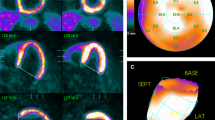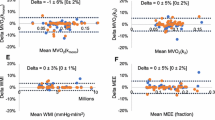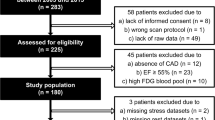Abstract
Increased regional myocardial 18F fluorodeoxyglucose (18FDG) uptake in relation to 13N ammonia (13NH3) uptake – i.e. glucose metabolism–blood flow ‘mismatch’ – appears to be a strong indicator of myocardial viability in patients with ischemic heart disease (IHD) and regionally reduced contractile function. Reference values of regional 18FDG and 13NH3 uptake have not been determined in healthy subjects with the target age for the development of IHD. We therefore studied healthy middle-aged and old men using positron emission tomography (PET). Twenty-three healthy men aged 51 to 83 years of age were studied. 18FDG and 13NH3 uptake was quantified in 16 myocardial segments with PET and circumferential profile analysis. The relative 18FDG/13NH3 uptake was considerably heterogeneous with 18FDG uptake consistently higher than 13NH3 uptake in the left lateral ventricular wall. This regional ‘mismatch’ pattern was observed in all subjects, but was most prominent in middle-aged men. The observed age-dependency was the result of a progressive increased in 13NH3 uptake with advancing age in the left ventricular lateral wall. Age-matched reference values of myocardial 18FDG and 13NH3 uptake appears to be important for the discrimination between physiological and pathological glucose metabolism–blood flow mismatch assessed by PET and circumferential profile analysis.
Similar content being viewed by others
References
Marshall RC, et al. Identification and differentiation of resting myocardial ischemia and infarction in man with positron computed tomography 18F-labeled fluorodeoxyglucose and N-13 ammonia. Circulation 1983; 67: 766-778.
Tillisch J, et al. Reversibility of cardiac wall-motion abnormalities predicted by positron tomography. N Engl J Med 1986; 314(14): 884-888.
Tamaki N, et al. Positron emission tomography using fluorine-18 deoxyglucose in evaluation of coronary artery bypass grafting. Am J Cardiol 1989; 64: 860-865.
Eitzman D, et al. Clinical outcome of patients with advanced coronary artery disease after viability studies with positron emission tomography. J Am Coll Cardiol 1992; 20(3): 559-565.
vom-Dahl J, et al. Relation of regional function, perfusion, and metabolism in patients with advanced coronary artery disease undergoing surgical revascularization. Circulation 1994; 90(5): 2356-2366.
Di Carli MF, et al. Long-term survival of patients with coronary artery disease and left ventricular dysfunction: implications for the role of myocardial viability assessment in management decisions. J Thorac Cardiovasc Surg 1998; 116(6): 997-1004.
Auerbach MA, et al. Prevalence of myocardial viability as detected by positron emission tomography in patients with ischemic cardiomyopathy. Circulation 1999; 99(22): 2921-2926.
Porenta G, et al. Semiquantitative assessment of myocardial viability and perfusion utilizing polar map displays of cardiac PET images. J Nucl Med 1992; 33: 1623-1631.
Berry JJ, et al. The effect of metabolic milieu on cardiac PET imaging using fluorine-18-deoxyglucose and nitrogen-13-ammonia in normal volunteers. J Nucl Med 1991; 32(8): 1518-1525.
Beanlands RS, et al. Heterogeneity of regional nitrogen 13-labeled ammonia tracer distribution in the normal human heart: comparison with rubidium 82 and copper 62-labeled PTSM. J Nucl Cardiol 1994; 1(3): 225-235.
Choi Y, et al. Factors affecting myocardial 2-[F-18]fluoro-2-deoxy-D-glucose uptake in positron emission tomography studies of normal humans. Eur J Nucl Med 1993; 20(4): 308-318.
Gropler RJ, et al. Nonuniformity in myocardial accumulation of fluorine-18-fluorodeoxyglucose in normal fasted humans. J Nucl Med 1990; 31(11): 1749-1756.
de Jong RM, et al. Posterolateral defect of the normal human heart investigated with nitrogen-13-ammonia and dynamic PET. J Nucl Med 1995; 36(4): 581-585.
Levy D, et al. Stratifying the patient at risk from coronary disease: new insights from the Framingham Heart Study. Am Heart J 1990; 119(3 Pt 2): 712-717.
Wei JY. Age and the cardiovascular system. N Engl J Med 1992; 327(24): 1735-1739.
Nyboe J, et al. Risk factors for acute myocardial infarction in Copenhagen. I: Hereditary, educational and socioeconomic factors. Copenhagen City Heart Study. Eur Heart J 1989; 10(10): 910-916.
Diamond GA, Forrester JS. Analysis of probability as an aid in the clinical diagnosis of coronary-artery disease. N Engl J Med 1979; 300(24): 1350-1358.
DeGrado TR, et al. Performance characteristics of a wholebody PET scanner. J Nucl Med 1994; 35(8): 1398-1406.
Knuuti MJ, et al. Euglycemic hyperinsulinemic clamp and oral glucose load in stimulating myocardial glucose utilization during positron emission tomography. J Nucl Med 1992; 33(7): 1255-1262.
Kofoed KF, et al. Fluorodeoxyglucose uptake in dysfunctional myocardium subtended by an occulded coronary artery. Relation to dobutamine contractile reserve and Sestamibi uptake. Int J Card Imaging 1998; 14(2): 97-104.
Olivetti G, et al. Gender differences and aging: effects on the human heart. J Am Coll Cardiol 1995; 26(4): 1068-1079.
Pearson AC, et al. Effects of aging on left ventricular structure and function. Am Heart J 1991; 121(3 Pt 1): 871-875.
Czernin J, et al. Influence of age and hemodynamics on myocardial blood flow and flow reserve. Circulation 1993; 88(1): 62-69.
Opie LH. Effects of regional ischemia on metabolism of glucose and fatty acids. Relative rates of aerobic and anaerobic energy production during myocardial infarction and comparison with effects of anoxia. Circ Res 1976; 38(5 Suppl 1): I52-I74.
Di Carli MF. Predicting improved function after myocardial revascularization. Curr Opin Cardiol 1998; 13(6): 415-424.
Greenbaum RA, et al. Left ventricular fibre architecture in man. Br Heart J 1981; 45(3): 248-263.
Barletta G, et al. Regional and temporal nonuniformity of shape and wall movement in the normal left ventricle. Cardiology 1998; 90(3): 195-201.
Sakata K, et al. Physiological fluctuation of the human left ventricle sympathetic nervous system assessed by iodine-123-MIBG. J Nucl Med 1998; 39(10): 1667-1671.
Bax JJ, et al. 18-Fluorodeoxyglucose imaging with positron emission tomography and single photon emission computed tomography: cardiac applications. Semin Nucl Med 2000; 30(4): 281-298.
Schwaiger M, Pirich C. Reverse flow-metabolism mismatch: what does it mean? J Nucl Med 1999; 40(9): 1499-1502.
Bax JJ, et al. Accuracy of currently available techniques for prediction of functional recovery after revascularization in patients with left ventricular dysfunction due to chronic coronary artery disease: comparison of pooled data. J Am Coll Cardiol 1997; 30(6): 1451-1460.
Tamaki N, et al. Prediction of reversible ischemia after revascularization. Perfusion and metabolic studies with positron emission tomography. Circulation 1995; 91(6): 1697-1705.
Marwick TH, et al. Functional status and quality of life in patients with heart failure undergoing coronary bypass surgery after assessment of myocardial viability. J Am Coll Cardiol 1999; 33(3): 750-758.
Maki M, et al. Glucose uptake in the chronically dysfunctional but viable myocardium. Circulation 1996; 93(9): 1658-1666.
Author information
Authors and Affiliations
Rights and permissions
About this article
Cite this article
Kofoed, K.F., Hove, J.D., Freiberg, J. et al. Relationship between regional 18F-fluorodeoxyglucose and 13N ammonia uptake in normal myocardium assessed by positron emission tomography: Patterns of mismatch and effects of aging. Int J Cardiovasc Imaging 17, 361–370 (2001). https://doi.org/10.1023/A:1011981526366
Issue Date:
DOI: https://doi.org/10.1023/A:1011981526366




